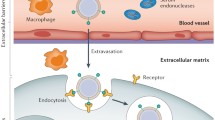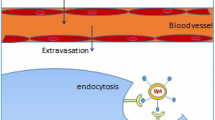Abstract
The dawn of nanoparticle-encapsulated genes is a revolutionary move in gene therapy. It promises to specifically and safely transport genetic cargo through biological systems within a non-viral “Trojan horse” system.
You have full access to this open access chapter, Download chapter PDF
Similar content being viewed by others
Keywords
These keywords were added by machine and not by the authors. This process is experimental and the keywords may be updated as the learning algorithm improves.
The dawn of nanoparticle-encapsulated genes is a revolutionary move in gene therapy. It promises to specifically and safely transport genetic cargo through biological systems within a non-viral “Trojan horse” system. Advances in non-viral-based physical (sonoporation, electroporation) and chemical (calcium phosphate) methods surmount biological barriers for a more efficient gene delivery and gene expression. This decade has witnessed lots of tailor-made gene delivery complexes and their evaluation. For example, magnetofection and sonoporation can be combined through the coadministration of magnetic nanoparticles and nonmagnetic microbubbles, followed by their activation by applying magnetic field and ultrasound. Recent hybrid nanocomplexes are not only attractive systems for gene delivery but also serve as nanoprobes for cellular fluorescent, PET, and MRI imaging and for gene evaluation by fluorescence, bioluminescence, or by radio-nucleotide reporter methods. There is a plethora of techniques available, and one can choose from radioactive-based to nonradioactive-based evaluation methods. Technological advances in imaging techniques assure better resolution and sensitivity; for example, with the advent of two-photon multiphoton microscopy over the traditional confocal microscopy, it is now able to image sixfold deeper than confocal microscopy when imaging the same sample using the same fluorophores. In the future, one needs to take advantage of these rapidly progressing imaging techniques and evaluation tools for maximum gene delivery using newer and safer targeted forms of non-viral systems. These nanosystems promise to be of both diagnostic and therapeutic value in the same breath.
Author information
Authors and Affiliations
Corresponding author
Editor information
Editors and Affiliations
Rights and permissions
Copyright information
© 2018 Springer International Publishing AG, part of Springer Nature
About this chapter
Cite this chapter
Slavcev, R.A. (2018). Conclusions and Perspectives. In: Slavcev, R., Wettig, S., Zeng, Z. (eds) Nanomedicine. Experientia Supplementum, vol 110. Springer, Cham. https://doi.org/10.1007/978-3-319-78259-1_5
Download citation
DOI: https://doi.org/10.1007/978-3-319-78259-1_5
Published:
Publisher Name: Springer, Cham
Print ISBN: 978-3-319-78258-4
Online ISBN: 978-3-319-78259-1
eBook Packages: Biomedical and Life SciencesBiomedical and Life Sciences (R0)




